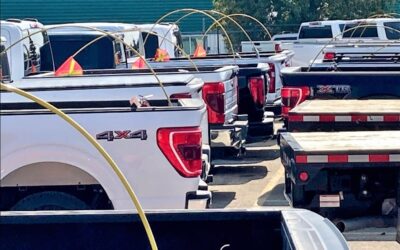This Public Fleet Improved Key Metrics in Just 2 Years
The CEM, CPFP and public fleet manager at Sarasota County in Florida, Ron Kennedy had been struggling with getting an adequate level of paper customer service surveys. After all, it does take a bit of effort and not all customers are inclined to respond. He wanted to change that and a very simple method was all he needed.
After attending a conference, he ate a sandwich at a restaurant. As he was leaving, he faced a machine that had five buttons asking for his opinion on the meal he just had. It was a standard machine with smiling and frowning faces. He really enjoyed the sandwich and pushed the happy button before walking out. It was only after, that he realized that he had participated in a survey conducted by the restaurant and thought it was a simple and effective way to capture feedback.
Mr. Kennedy decided to purchase one of these machines for each of the facilities in Sarasota County, Florida. His aim was to ask each of the customers to rate their experience with the public fleet’s services as well as their interactions with the staff. Once implementing the survey machines, he was able to attain and measure feedback to identify areas needing improvement.
Within the past couple of years, Ron Kennedy has made numerous changes to the fleet and provided the necessary oversight to complete existing projects. Even with all the success he has experienced for the fleet so far, he is still working on introducing more improvements to the fleet.
Shifting Things Around
Some of the major changes that the public fleet management team has accomplished are centered on the aspect of safety, preventative maintenance and staff training. There is a new safety program with a training officer who has training from OSHA itself. The officer travels to each of the facilities every month, conducting talks about safety.
The program has made a marked difference when it comes to reinforcing safety measures for the public fleet across the board.
Kennedy’s emphasis on preventative maintenance is also strong. This increased focus on preventative maintenance created a drastic reduction in reactive maintenance that cut down the costs for the company by over 20 percent.
Because of this, all three facilities obtained a Blue Seal of Excellence from the ASE (National Institute for Automotive Service Excellence). The public fleet management achieved this feat by making employee training and paying them for their certifications a priority.
Public Fleet Major Projects
Under the guidance of Kennedy, the fleet team is continuously working on new projects springing up here. Through years of deliberation and design, the public fleet management team is jumpstarting an effort to rebuild three of the fleet’s four fuel islands.
Sarasota County’s underground fuel storage tanks also need replacement with many requiring replacement with above-ground tanks. Kennedy aims to double the capacity at each of the sites.
Another major project underway is moving the public fleet’s entire data on to a server for better security and accessibility. The current system tracks are quite reliable, but Kennedy felt there is plenty of room to improve. The aspect of manually extracting data is obsolete and time-intensive. This change will see the fleet management staff significantly improve access to KPIs through their phones, among many other benefits.
The changes will allow everybody to keep track of how the fleet is performing. A staff member located in the Emergency Operations Center during a hurricane will have easy access to the fuel levels. Right now, the member has to call the fleet office manually on an hourly basis to keep track of this aspect.
Complete Recruitment for Technicians
At this point in time, the public fleet in Sarasota County, Florida is fully staffed. This is the first time the fleet has been fully staffed in the two years. It was a long standing problem for the fleet but over the past six months, the fleet has managed to hire some great technicians to the team.
The fleet’s focus is not getting technicians who have been in the industry for the past few decades. As good as the experience can be, their emphasis is on people with training for the way modern fleets work. They want people who are hungry to start a career and not people who are in the twilight of their careers.
This recruitment strategy is not limited to the technician level. It is also bolstering the ranks in its administrative department for a comprehensive approach to revitalizing the fleet successfully.
Customer Service Tracking
One of the most important parts of the public fleet operations is customer service. The new “Happy, Not Happy” machines Kennedy installed in each of the facilities aligns with their emphasis on customer service tracking to better understand where the fleet stands. The superintendents need to make sure there is an effort to remind customers to rate their interactions with the fleet. In order to encourage them, Kennedy has stated that the results of these surveys will be a part of their evaluations.
The digital system allows Kennedy to track the time and location of the results, receiving them in direct emails on a daily basis. It allows him to rule out any accidental pushes of the buttons by the cleaning staff after hours. This proactive approach has allowed the public fleet to get a better measure of all the customer interactions, their opinions, and the necessary measures needed to make their operations even better.
Kennedy emphasizes each and every interaction, not just the ones with the direct customers of the fleet. Even with the internal mail services, the staff that delivers the mail every day rate the organization. The fleet staff makes a point to greet them at the door every day without fail. While it might seem like a tiny gesture, it creates a world of a difference when it comes to the progress of the company and its endeavors to continuously improve.
Source: https://www.government-fleet.com/326107/2-years-in-sarasota-county






